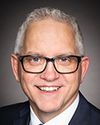Thank you.
Aaniin, boozhoo kina weyaa.
My name is Hayden King. I'm from Beausoleil First Nation on Gchi'mnissing, which is a small island Indian reserve, an Ojibwa and Potawatomi community, about two hours north of Toronto by car and by boat.
I am also the executive director of the Yellowhead Institute, which is a research and education centre based out of the Toronto Metropolitan University in Toronto. My research and analysis revolves around the land. I am the co-author of the agenda-making report “Land Back”. I study modern treaty implementation revolving around land and resources, and I work on rearticulating Anishinabe diplomacy and law around hunting and land management. This is the context from which I speak to you all today.
I believe that any discussion of land back has to begin with the discussion of land theft. The demands that indigenous people and indigenous young people are making today for restitution are old calls, the oldest calls. The oldest protest in the country is for the return of lands and resources that have been taken “by hooks and crooks”, as Deskaheh once said.
The doctrine of discovery, that piece of international imperial law, was the foundation of the world's greatest plunder, and it's what Canadian courts have relied upon when hearing the first indigenous land disputes. The doctrine of discovery declared indigenous peoples inhuman, not worthy of rights and certainly not worthy of property rights.
When courts realized the basis of Canadian sovereignty might be questioned using this rationale, arguments for possession shifted to treaties. In other words, Canada owns the land by virtue of negotiating treaties, but this isn't quite right either. In Ontario, pre-Confederation treaties were sharing pacts that were almost nearly immediately broken and used to relocate indigenous people, communities and families. The people who call my community home—Beausoleil First Nation or Gchi'mnissing—were relocated four times and pushed west and south to make way for settlement. Over the Great Lakes and into the Prairies, the so-called Confederation-era numbered treaties followed the trend. Treaty commissioners promised one thing and enforced another, and that enforcement was buttressed, supported and upheld by public officials and the courts.
As a common-law legal infrastructure became entrenched in Canada, indigenous people had few avenues to express the view that treaties were not negotiated to surrender or to cede, but to share in a spirit of mutual respect. It didn't help, of course, that the Indian Act made hiring a lawyer illegal.
Elsewhere in the country, treaties simply were not made, which, even by Canadian law inherited from the English, meant that indigenous people still had some form of title to it. However, here, too, indigenous people have struggled to find an audience as the constitutional division of powers has carved up our territories and the responsibility for them among the provinces, along with deploying the concept of Crown lands.
Today, when indigenous people call for land back, especially in those areas where no treaties have been made, the federal government can conveniently hide behind federalism. In this atmosphere of fictive legal possession of indigenous lands, how can we get land back? There are a variety of tools currently deployed, most commonly the specific and comprehensive claims processes, but they rarely transfer land. Instead, they provide compensation as a form of redress to buy land back and, in some cases—and this was the former Crown-indigenous relations minister's position on land back—turn it into Indian land via the additions to reserve policy.
These tools are inadequate. Instead, why not have a framework for the transfer of Crown lands that, rightfully, are indigenous lands, and related government-owned properties and territories, to indigenous people? Why not, perhaps, have a program to support first nations with resources to develop a national land restitution centre and innovate a tax-free way to reclaim land and fee simple?
There are many private citizens and organizations that are increasingly keen to transfer those lands back to indigenous people, but they lack the tools to do so. Building on models and modern treaty contexts, what about comanagement regimes that eventually give way to exclusive indigenous management? What about a renewed approach to criminalizing indigenous people defending their land? What about the development of a framework to discuss what we mean by treaties and treaty implementation, both historical and modern?
Why not, in the interim, as we work all of this out, deploy free, prior and informed consent? That's something the federal government committed to in the United Nations declaration act action plan. While the duty to consult is limited and narrow, it is broad in scope. Perhaps, even through federal legislation, free, prior and informed consent could be deployed to allow indigenous people to have de facto authority and make decisions on their lands and territories, and on the resources that come along with those. Free, prior and informed consent can unlock both land restitution and self-government, in fact.
Regardless of what the federal government decides to do with this study, or with future policy or law, indigenous people will continue to innovate, push and enforce their own vision of land back, making it the next-generation indigenous rights paradigm.
Ahow, meegwetch.
I look forward to the discussion.



